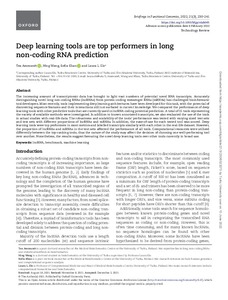Deep learning tools are top performers in long non-coding RNA prediction
Elo Laura L; Ammunét Tea; Wang Ning; Khan Sofia
Deep learning tools are top performers in long non-coding RNA prediction
Elo Laura L
Ammunét Tea
Wang Ning
Khan Sofia
OXFORD UNIV PRESS
Julkaisun pysyvä osoite on:
https://urn.fi/URN:NBN:fi-fe2022081153829
https://urn.fi/URN:NBN:fi-fe2022081153829
Tiivistelmä
The increasing amount of transcriptomic data has brought to light vast numbers of potential novel RNA transcripts. Accurately distinguishing novel long non-coding RNAs (lncRNAs) from protein-coding messenger RNAs (mRNAs) has challenged bioinformatic tool developers. Most recently, tools implementing deep learning architectures have been developed for this task, with the potential of discovering sequence features and their interactions still not surfaced in current knowledge. We compared the performance of deep learning tools with other predictive tools that are currently used in lncRNA coding potential prediction. A total of 15 tools representing the variety of available methods were investigated. In addition to known annotated transcripts, we also evaluated the use of the tools in actual studies with real-life data. The robustness and scalability of the tools' performance was tested with varying sized test sets and test sets with different proportions of lncRNAs and mRNAs. In addition, the ease-of-use for each tested tool was scored. Deep learning tools were top performers in most metrics and labelled transcripts similarly with each other in the real-life dataset. However, the proportion of lncRNAs and mRNAs in the test sets affected the performance of all tools. Computational resources were utilized differently between the top-ranking tools, thus the nature of the study may affect the decision of choosing one well-performing tool over another. Nonetheless, the results suggest favouring the novel deep learning tools over other tools currently in broad use.
Kokoelmat
- Rinnakkaistallenteet [19207]
